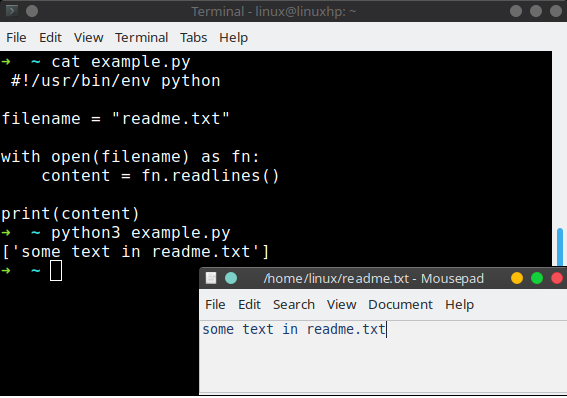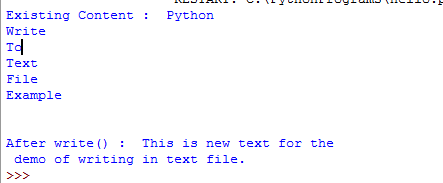

So basically, we put in the line number we are writing, a carriage return, and a new line character. The output we want to iterate in the file is “ this is line number“, which we declare with a write function and then percent d (displays integer). Using Python, write a function to enter data into the file. We have the for loop that runs over a range of 11 numbers.
PYTHON WRITE TO FILE PLUS
# sample.txtĭisney plus is launched in 3 countriesThis is line 1 We are now appending 11 more lines, so let’s see the output.

We have already created a sample.txt file, and there is already one line of text. Notice that we opened a file, write a file, and then closed a file using the close() function. If you run the above code, it will write the “ Disney plus is launched in 3 countries” in the already existing sample.txt file. “w” – Write – It will overwrite any existing content.į.write("Disney plus is launched in 3 countries") “a” – Append – It will append to the end of the file. To write to an existing file in Python, you must add the parameter to the open() function: In the above code, we have passed the “w,” which means it will create a file if it does not exist, and it won’t give any error if the file does not exist. Here we used the “x” letter in our argument, which indicates create the file, and if it exists, then return FileExistsError: File exists: ‘sample.txt”, you rerun the above code, it will give the FileExistsError. The open() function takes two arguments: the file we want to open and the string representing the kinds of permission or operation we want to do on the file. We declared a variable f to open the file named sample.txt. It will create a new empty file is created! In the above code, we are creating a file with the parameter ‘x.’ That means i f the file already exists, it will return an error. file.close() to close the file.įile = open("stud.txt" image shows the output in which the values of the variables are displayed in the new file created.“w” – Write – will create a file if the specified file does not exist. write(‘value of the variable’) to get the values assigned to the variable in the textfile created. In this example, I have taken three variables and file = open(“filename.txt, mode) to open the file and used file. In the below example, you can see, I have used \n to write Car Name, Car Year, and Car color in new lines. In Python \n is the newline character which is used when we want to write on a new line.

PYTHON WRITE TO FILE HOW TO
Let us see how to write variable to file with newline in Python. In the below code, I am using file.open(“file.txt”,mode) to open the file.įile.close Python write variable to file newline Let us see how to write variable to file with open. This output is displayed in the new file created named as “car.txt”. carname="Swift"įile.write("Car Name = " + carname + "\n" +"Car Year = "+caryear + "\n"+"Car color = "+carcolor )īelow image shows the output. Then use the file.close() method to close the created file. Here the contents are carname, caryear, and carcolor. We can use the “w” mode to write the file and there are other modes in the files such asĪfter opening the file, I used file.write() method to write the contents in the file. I am using file = open(“filename.txt”, “mode”) and used filename as car.txt. I am taking three Python variables as carname, caryear, and carcolor, and assigning them a value and next to open a file. In this example, I will show two ways to write values of a variable in Python to a text file.Īlso you can check, Python write String to a file String Concatenation Now, we will see how to write a variable value to a text file in Python. Python save variable to file pickle How to write variable to a file in Python?


 0 kommentar(er)
0 kommentar(er)
